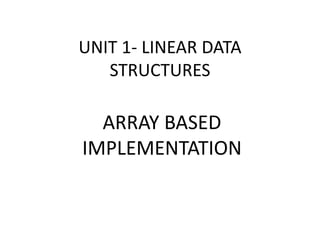
Unit 1 array based implementation
- 1. UNIT 1- LINEAR DATA STRUCTURES ARRAY BASED IMPLEMENTATION
- 2. Introduction • An Array is a collection of memory locations. • The memory locations cannot be split from each other, so if there is some empty space, it just goes waste. • Arrays cannot be interchanged. • A array is a collection of variables of same type.
- 3. • Some points to be noted about an array: 1. It is a continuous chunk of memory with equally sized blocks. 2. The subscript always begins with ‘0’ and goes until ‘n-1’ which is also continuous. 3.Any memory location can be directly accessed using its subscript. 4. Static arrays have issues, such as memory wastage and memory leak, and also have constraints over the size. These are overcome by using dynamic arrays. 5. Since it is a continuous chunk of memory, it has internal issues such as fragmentation and memory leaks.
- 4. Why do we study Arrays? • The array structure looks very similar to Python's list structure. • But there are two major differences between the array and the list. 1. array has a limited number of operations whereas Lists provides a large number of operations for working with the contents of the list. 2. lists can grow and shrink during execution as elements are added or removed while the size of an array cannot be changed after it has been created. • The array is best suited for problems requiring a sequence in which the maximum number of elements are known up front, whereas the list is the better choicewhen the size of the sequence needs to change after it has been created.
- 5. Array Abstract Data Type • Definition: A one-dimensional array is a collection of contiguous elements in which individual elements are identified by a unique integer subscript starting with zero. Once an array is created, its size cannot be changed.
- 6. • Array( size ): Creates a one-dimensional array consisting of size elements with each element initially set to None. size must be greater than zero. • length (): Returns the length or number of elements in the array. • getitem ( index ): Returns the value stored in the array at element position index. The index argument must be within the valid range. Accessed using the subscript operator. • setitem ( index, value ): Modifies the contents of the array element at position index to contain value. The index must be within the valid range. Accessed using the subscript operator. • clearing( value ): Clears the array by setting every element to value. • iterator (): Creates and returns an iterator that can be used to traverse the elements of the array.
- 7. Basic operations of Arrays Array( size ): Creates a one-dimensional array consisting of size elements with each element initially set to None. size must be greater than zero. length (): Returns the length or number of elements in the array. getitem ( index ) Returns the value stored in the array at element position index. The index argument must be within the valid range. Accessed using the subscript operator. setitem ( index, value ) Modifies the contents of the array element at position index to contain value. The index must be within the valid range. Accessed using the subscript operator. clearing( value ) Clears the array by setting every element to value. iterator () Creates and returns an iterator that can be used to traverse the elements of the array.
- 8. The ctypes Module • Many of the data types and classes available in Python are actually implemented using appropriate types from the C language. • While Python does not provide the array structure as part of the language itself, it now includes the ctypes module as part of the Python Standard Library. • The ctypes module provides the capability to create hardware- supported arrays just like the ones used to implement Python's string, list, tuple, and dictionary collection types. • But the ctypes module is not meant for everyday use in Python programs. • Thus, the technique provided by the module for creating an array should not typically be used directly within a Python program. • But we can use it within our Array class to provide the functionality defined by the Array ADT.
- 10. Syntax of Arrays
- 11. Creating an Array in Python • In Python, arrays are different from lists; lists can have array items of data types, whereas arrays can only have items of the same data type. • Python has a separate module for handling arrays called array, which you need to import before you start working on them.
- 12. Ways to create Arrays • You can declare an array in Python while initializing it using the following syntax.
- 13. • Identifier: specify a name like usually, you do for variables • Module: Python has a special module for creating arrays, called "array" – you must import it before using it • Method: the array module has a method for initializing the array. It takes two arguments, typecode, and elements. • Type Code: specify the data type using the typecodes available. • Elements: specify the array elements within the square brackets, for example [130,450,103]
- 14. Accessing an Array value
- 15. Array Operations - Insertion
- 17. Array Operations - Searching
- 19. Array Operations - Traverse
